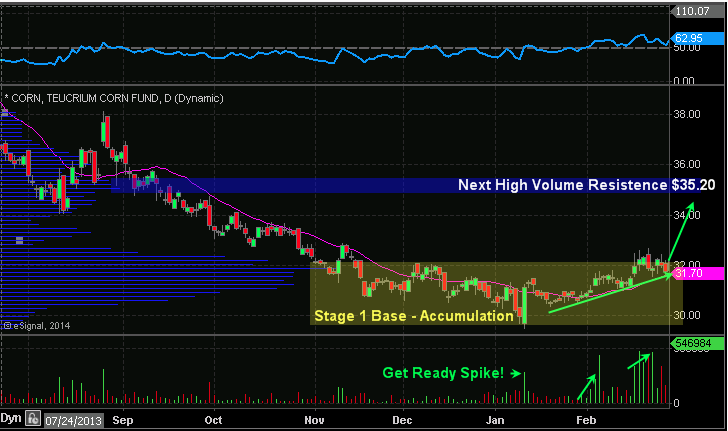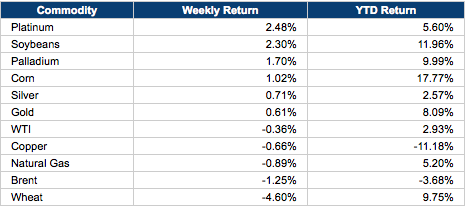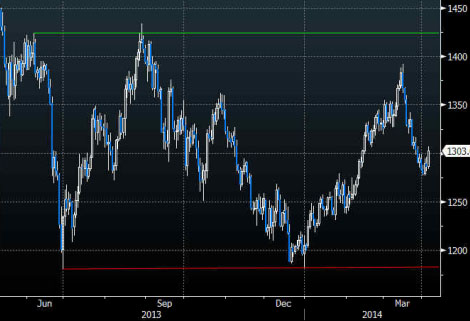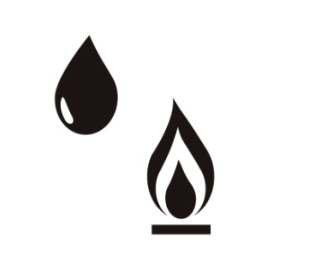Energy & Commodities
We have been watching the commodities index rally for a few weeks now with natural gas, coffee, sugar, gold, silver and several others jump in price. We have been watching the GCC ETF which is a basket of several commodities to get a feel for the commodities market as a whole.
While most of the commodities have posted some solid gains, CORN has yet to pop in price. Corn looks to be forming a stage 1 basing pattern and the volume/money flowing into this fund suggest new money is moving into corn because it looks as though it will be the last to pop and rally in price.
This is similar to how we entered the silver trade a few weeks back. Everything else in the precious metals sector popped and silver lagged giving us a high probability setup.
Both the short and long term the charts of corn look bullish. As usual I will lock in some gains if we get a pop in the commodity, then let the balance ride with a break even stop. If corn is entering a new bull market phase (Stage 2) I want to hold some long term. There is potential for a 19%-30% rise in value.
Corn Trade Information:
Buy CORN etf, Stop $29.90, Downside Risk 6%, Portfolio Size 6%

also: (scroll down)
ETF Trading Newsletter – CORN ALERT #2

 Strikes at South African mines have caused a massive drop in platinum and palladium production. And the world’s palladium supply could decline by 41% overnight if the West imposes export sanctions on Russia. Speculators are betting that these events will reduce supply of the metals and drive up prices.
Strikes at South African mines have caused a massive drop in platinum and palladium production. And the world’s palladium supply could decline by 41% overnight if the West imposes export sanctions on Russia. Speculators are betting that these events will reduce supply of the metals and drive up prices.
Rick Rule, chairman and founder of Sprott Global Resource Investments Ltd., recently weighed in. He believes platinum and palladium could go lower in the near term, as fears of a sudden crunch dissipate.
The real reason platinum and palladium should rise over the coming years has nothing to do with geopolitics or labor issues, he believes. Rick begins:
“The political dispute with Russia is not particularly relevant to the platinum and palladium industry, except in the extremely short term. Cutting off exports from Russia is not in the West’s interest, and certainly not in Russia’s interest. So I doubt that a politically motivated ban on exporting the metals will arise.”
As these fears subside, it could take the metals’ prices lower, as speculators focus on short-term effects. Meanwhile, Russia’s exports are likely to decrease for other reasons, which many investors might miss:
“The supply of platinum and palladium from Russia is threatened by decreasing ore grades at depth in the Norilsk mines, where most of the metals are mined. These mines have been in operation since the early 20th century, so they are likely nearly depleted.
“New mines in Russia are probably 10 years away. So at least for the next decade, production should continue to decrease as deposits are increasingly mined out.
In South Africa, Rick believes labor disputes will plague the industry until big miners are simply forced to shut down. These strikes and violence are symptoms of how harsh conditions have become in platinum and palladium mines as they go ever deeper to produce ore. These companies still generate insufficient cash flow to pay their workers well.
…..read page 2 HERE

WEEK IN REVIEW: GOLD REBOUNDS; CONFLICTING SIGNALS FROM LIBYA SINK OIL; CORN UP
Gold finally rebounded back above the $1,300 level, while Brent briefly hit a five-month low.
Precious metals, soybeans and corn were the big winners in commodity markets this week, while oil, copper and wheat fared poorly. Stocks touched all-time highs, but finished the period off their best levels. The S&P 500 increased 0.8 percent, bringing its year-to-date gain to 1.3 percent. On Friday, the index briefly touched 1,897—a new intraday record.
Macroeconomic Highlights
The biggest economic release of the week was the monthly employment report in the U.S. According to the Bureau of Labor Statistics, private employers added 192K jobs in March, just a tad below the 200K that was expected. At the same time, the unemployment rate held steady at 6.7 percent.
In other news, ISM reported that the manufacturing sector in the U.S. accelerated slightly in March. The ISM manufacturing index rose from 53.2 to 53.7 in March. Meanwhile, ISM reported that its U.S. non-manufacturing gauge for March rebounded from 51.6 to 53.1. Levels above 50 represent expansion, while levels below 50 represent contraction.
Elsewhere, the ECB kept its benchmark overnight interest rate steady at a record-low 0.25 percent, as was widely expected. Speaking to journalists after the policy decision, ECB President Mario Draghi said the central bank does not exclude further monetary easing. He also said that ECB officials were unanimous on using unconventional policy tools if necessary—including quantitative easing.
The ECB has kept monetary policy extremely accommodative amid low levels of inflation and high levels of unemployment. Eurostat reported that the CPI in the eurozone in March grew by only 0.5 percent year-over-year, down from 0.7 percent the previous month and the slowest pace since 2009. The core CPI, which excludes food and energy prices, grew by 0.8 percent in March, down from 1 percent in February.
Finally, in China, the government released its official manufacturing PMI for March. The index edged up from 50.2 in February to 50.3, close to expectations. At the same time, HSBC’s manufacturing gauge for China—which measures smaller firms in the country—edged down from 48.1 to 48, also close to expectations. Levels above 50 represent expansion, while levels below 50 represent contraction.
Commodity Wrap

Gold bounced back this week as bargain hunters entered the market following recent losses. As we wrote earlier this week (see Rising Interest Rates Won’t Push Gold To New Lows; Buy On Pullbacks), the recent $112 decline in prices was a short-term reaction to the Fed’s hawkish outlook for interest rates laid out in its last meeting on March 19.
However, gold is not at risk of falling into a major downtrend or hitting new lows below the cycle low at $1,180. We remain buyers on the dips and see the likelihood of another rally to $1,400 or higher later this year.

….read page 2 and the rest of the commodity wrap HERE

 A Global Boom in agriculture investments caused by rising food prices was forcast in 8 REASONS AGRICULTURE STOCKS ARE HEADED MUCH, MUCH HIGHER and FARMERS WILL BE DRIVING THE LAMBORGHINIS. This seems to be happening as you can see below – Editor Money Talks
A Global Boom in agriculture investments caused by rising food prices was forcast in 8 REASONS AGRICULTURE STOCKS ARE HEADED MUCH, MUCH HIGHER and FARMERS WILL BE DRIVING THE LAMBORGHINIS. This seems to be happening as you can see below – Editor Money Talks
Global food prices rose to their highest in almost a year in March, led by unfavourable weather for crops and political tensions over Ukraine, the United Nations food agency said on Thursday.
The Food and Agriculture Organisation’s (FAO) price index, which measures monthly price changes for a basket of cereals, oilseeds, dairy, meat and sugar, averaged 212.8 points in March, up 4.8 points or 2.3 percent from February. The reading was the highest since May 2013.
….read more HERE

 7 Energy stocks with catalysts that could boost valuations are what Fadel Gheit recommends.
7 Energy stocks with catalysts that could boost valuations are what Fadel Gheit recommends.
Gheit is managing director and senior analyst covering the oil and gas sector for NewYork-based Oppenheimer & Co.
He has been an energy analyst since 1986 and was named to The Wall Street Journal All-Star Annual Analyst Survey four times.
HAI’s Sumit Roy caught up with Gheit recently to discuss the latest developments in the oil and gas markets.
His recommendations are HERE











